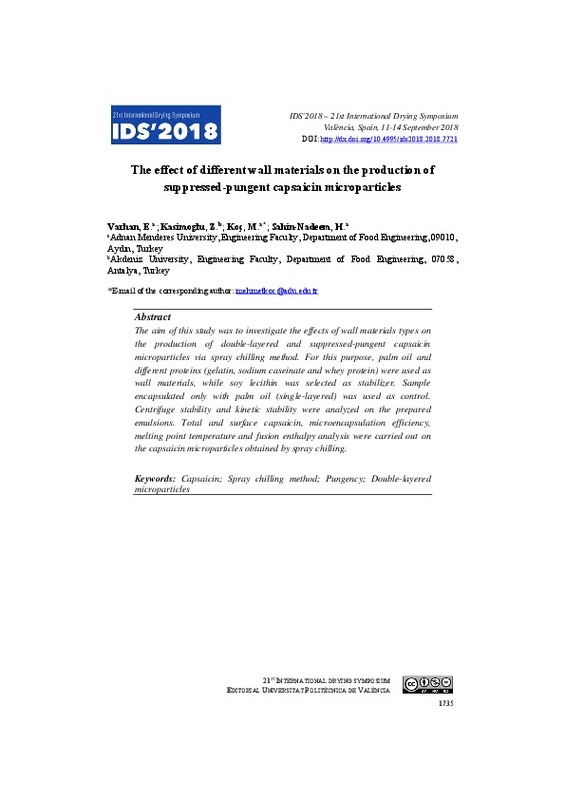JavaScript is disabled for your browser. Some features of this site may not work without it.
Buscar en RiuNet
Listar
Mi cuenta
Estadísticas
Ayuda RiuNet
Admin. UPV
The effect of different wall materials on the production of suppressed-pungent capsaicin microparticles
Mostrar el registro sencillo del ítem
Ficheros en el ítem
| dc.contributor.author | Varhan, Emine
|
es_ES |
| dc.contributor.author | Kasımoğlu, Zehra
|
es_ES |
| dc.contributor.author | Koç, Mehmet
|
es_ES |
| dc.contributor.author | Şahin Nadeem, Hilal
|
es_ES |
| dc.date.accessioned | 2019-02-15T08:17:11Z | |
| dc.date.available | 2019-02-15T08:17:11Z | |
| dc.date.issued | 2018-09-07 | |
| dc.identifier.isbn | 9788490486887 | |
| dc.identifier.uri | http://hdl.handle.net/10251/116764 | |
| dc.description.abstract | [EN] The aim of this study was to investigate the effects of wall materials types on the production of double-layered and suppressed-pungent capsaicin microparticles via spray chilling method. For this purpose, palm oil and different proteins (gelatin, sodium caseinate and whey protein) were used as wall materials, while soy lecithin was selected as stabilizer. Sample encapsulated only with palm oil (single-layered) was used as control. Centrifuge stability and kinetic stability were analyzed on the prepared emulsions. Total and surface capsaicin, microencapsulation efficiency, melting point temperature and fusion enthalpy analysis were carried out on the capsaicin microparticles obtained by spray chilling. | es_ES |
| dc.description.sponsorship | The authors acknowledge TUBITAK-TOVAG (Project Number: 116 O 499) for financial support. | es_ES |
| dc.format.extent | 8 | es_ES |
| dc.language | Inglés | es_ES |
| dc.publisher | Editorial Universitat Politècnica de València | es_ES |
| dc.relation.ispartof | IDS 2018. 21st International Drying Symposium Proceedings | es_ES |
| dc.rights | Reconocimiento - No comercial - Sin obra derivada (by-nc-nd) | es_ES |
| dc.subject | Drying | es_ES |
| dc.subject | Dehydration | es_ES |
| dc.subject | Dewatering | es_ES |
| dc.subject | Emerging technologies | es_ES |
| dc.subject | Products quality | es_ES |
| dc.subject | Process control | es_ES |
| dc.subject | Environmental | es_ES |
| dc.subject | Evaporation | es_ES |
| dc.subject | Sublimation | es_ES |
| dc.subject | Diffusion | es_ES |
| dc.subject | Energy | es_ES |
| dc.subject | Intensification | es_ES |
| dc.subject | Capsaicin | es_ES |
| dc.subject | Spray chilling method | es_ES |
| dc.subject | Pungency | es_ES |
| dc.subject | Double-layered microparticles | es_ES |
| dc.title | The effect of different wall materials on the production of suppressed-pungent capsaicin microparticles | es_ES |
| dc.type | Capítulo de libro | es_ES |
| dc.type | Comunicación en congreso | es_ES |
| dc.identifier.doi | 10.4995/IDS2018.2018.7721 | |
| dc.relation.projectID | info:eu-repo/grantAgreement/TUBITAK//TOVAG-116 O 499/ | |
| dc.rights.accessRights | Abierto | es_ES |
| dc.description.bibliographicCitation | Varhan, E.; Kasımoğlu, Z.; Koç, M.; Şahin Nadeem, H. (2018). The effect of different wall materials on the production of suppressed-pungent capsaicin microparticles. En IDS 2018. 21st International Drying Symposium Proceedings. Editorial Universitat Politècnica de València. 1735-1742. https://doi.org/10.4995/IDS2018.2018.7721 | es_ES |
| dc.description.accrualMethod | OCS | es_ES |
| dc.relation.conferencename | 21st International Drying Symposium | es_ES |
| dc.relation.conferencedate | Septiembre 11-14, 2018 | es_ES |
| dc.relation.conferenceplace | Valencia, Spain | es_ES |
| dc.relation.publisherversion | http://ocs.editorial.upv.es/index.php/IDS/ids2018/paper/view/7721 | es_ES |
| dc.description.upvformatpinicio | 1735 | es_ES |
| dc.description.upvformatpfin | 1742 | es_ES |
| dc.type.version | info:eu-repo/semantics/publishedVersion | es_ES |
| dc.relation.pasarela | OCS\7721 | es_ES |
| dc.contributor.funder | Technological Research Council of Turkey |








